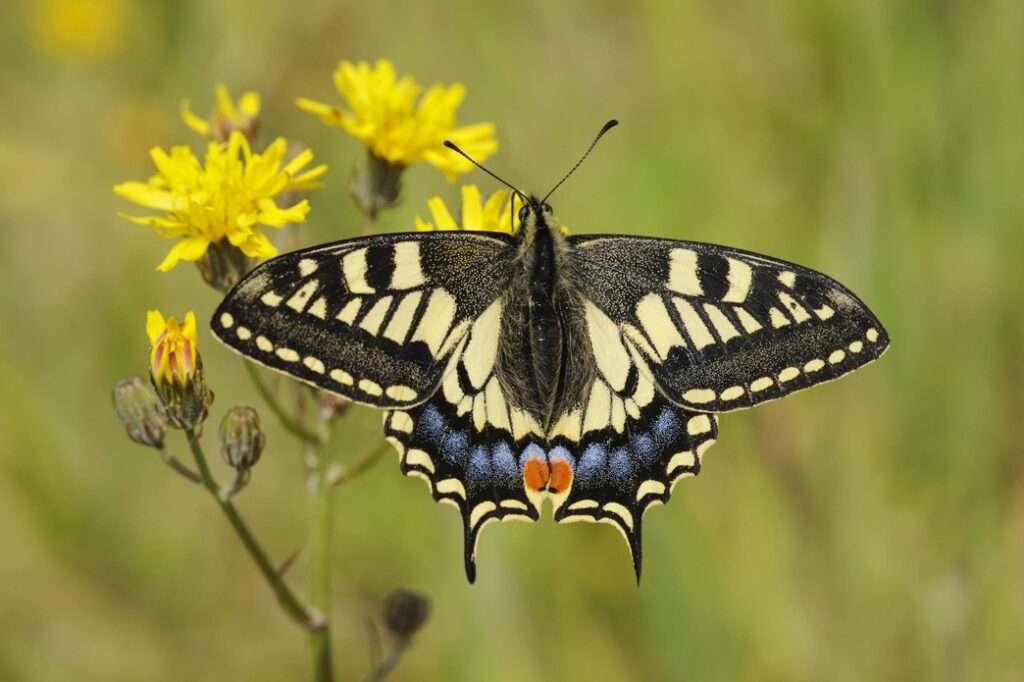
Butterfly wings are available in a wonderful variety of hues and designs. Not only are they lovely, but they have a function. They can absorb heat, blend in with their surroundings, or assist butterflies in finding a partner. Vibrant colors serve as a warning to predators to avoid harmful species.

Wing Colors
Butterfly wings can have colors derived from structural colour or colored pigments. Or even a mix of the two.
The way you’re generally used to thinking about colored pigments is how they operate. The molecules themselves are colored, just as the pigments in crayons and colored pencils. Instead, they reflect some colors of light while absorbing the majority, and humans interpret the reflected light as colour. Some of the common pigment kinds made by butterflies are included in the table below. Each of these pigment kinds can produce colors that are more or less strong depending on the quantity or density used.
Structured pigments are the source of blues. Instead of being blue, the molecules are black. However, they reflect blue light due to their microscopic form. They have a metallic or iridescent appearance as a result. They seem bright blue or black, depending on the light’s strength and angle. Another structural colour found in butterflies is white. Usually, light-reflecting tiny air bubbles are the source. Feathers from birds also frequently exhibit structural colour.
Proteins are used to construct all of these structures and pigments. Protein clusters function similarly to assembly lines, transforming basic components into vibrantly colored molecules. Genes contain the coding sequences needed to make proteins. Protein differences may result from differences in genes. Furthermore, the colour and intensity of a pigment that the protein aids in the development of may be impacted by these variations.


Wings Pattern
Certain genes function similarly to paintbrushes, applying different colors to different areas of the wing.
Every species in each of the three major families of butterflies uses a common core set of genes to produce colors. Where these pigment-making assembly lines (or pathways) are active is determined by another set of genes. They are able to turn on and off whole paths. Different locations on the wing can produce different hues depending on the alleles of these “control genes.”
Small variations in when and where of these regulatory genes’ activation can result in significant changes. In fact, variations in a surprisingly small number of genes account for the wide variety in butterfly wing colors and patterns.
These butterflies from the Heliconius genus have a variety of wing patterns, which can be produced by variations in a small number of genes. The Creative Commons Attribution 2.5 Generic license applies to this photograph.

A Few Genes with Big Effects
The Nymphalid family of butterflies is known for its vivid hues and varied patterns. Researchers studying into these species have found that variations in just four genes account for almost all of their variety.
Optix is famous for its ability to produce long, narrow ray patterns and huge colour spots. This gene influences several colour production routes simultaneously, much like a control switch. Melanin (black and grey) production is turned off and ommachrome (red, orange, and tan) production is turned on in areas where optix is active. Optic is also engaged in structural blue colour in certain animals; this colour is composed of pigments derived from black melanin.
In certain species, cortex influences black pigment patterns; in others, it impacts white and yellow. It might function by influencing the rate at which the cells making up scales mature. Typically, black scales grow more slowly than other colors.
The transition between yellow and white patterns is impacted by aristaless. It frequently results in patches on the underside of the hindwing or bands on the fore and hindwings.
WntA changes the size and form of stripes and spots that are applied by cortex and optix.
Some species of butterflies are distinguished by their brilliant eyespots. Predators may be scared off or distracted from vital organs through these bright targets. In the core of many eyespots, two genes are active: distalless and spalt.
Different families of butterflies employ distinct sets of regulatory genes, yet they function similarly. Such genes facilitate remarkable adaptability and swift changes within species. A population doesn’t need new color-building or pattern-making genes to emerge from nothing for its patterns to change. Rather, minute modifications to already-existing genes can create new patterns with almost infinite permutations.




